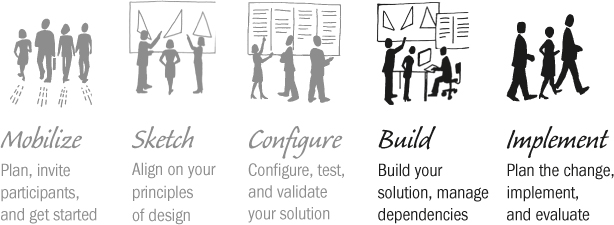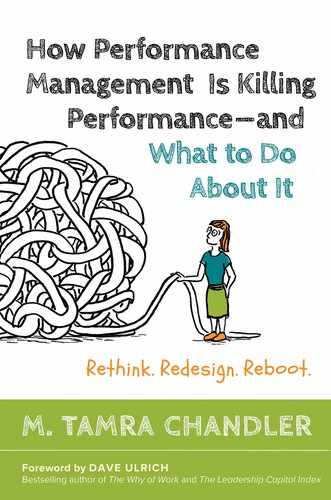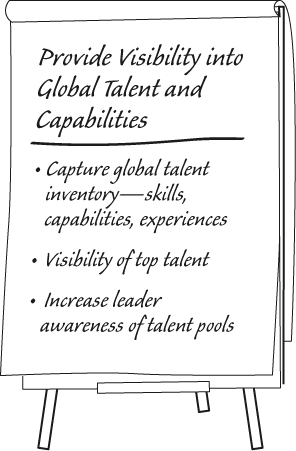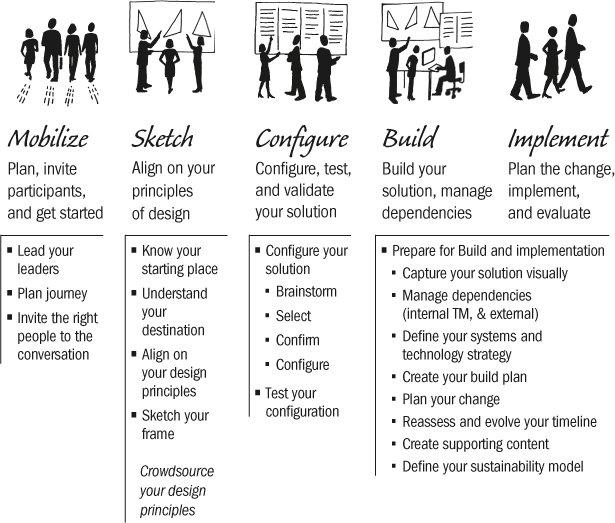Chapter 9
BUILD AND IMPLEMENT

WHILE THE FIRST THREE PHASES of our PM Reboot process can be a wild ride, the nice thing about them is that you usually can control the process and the timeline as you see fit. But don’t expect that degree of control to last into Build and Implement. These final process phases will have far more variability because of the many dependencies that are impacted by performance programs. These dependencies often include the business calendar, other talent programs and initiatives, system and tool requirements for development and implementation, and the readiness of your team to take on the shifts you’re introducing. You will find that understanding and managing these dependencies is absolutely imperative in these final two phases. You’re going to have to spend some time on them in addition to the creative and tactical work of designing and creating the tools and content that will support your ultimate solution. So instead of telling you exactly how to build each of your PM Practices, let me instead share my experiences in managing those many dependencies in order to help you look like an implementation superstar.
CAPTURE YOUR SOLUTION VISUALLY. A picture paints a thousand words, they say, and you’ve devoted a lot more than a thousand words to discussing the design process. So with the design work complete, it’s time to make sure you’ve captured your design in a way that is comprehensive and easy to understand and share by creating a picture of it. Not only is a visual image an important tool for guiding your work during the Build and Implement phases, but also it’s immensely valuable as a way to make sure your stakeholders have a shared understanding of how all the pieces (in this case, your PM Practices) come together. When done well, a great visual summary will carry you from the early validation of your solution design right through training and onboarding. I provide suggestions and examples for how to create your visual at www.thePMReboot.com.
MANAGE YOUR SOLUTION DEPENDENCIES. The three dependencies that are most likely to influence you in the Build and Implement phase are other talent management processes and programs, systems and tools requirements, and processes that you don’t own, such as strategic planning. It’s critical that you dedicate sufficient time and energy to understanding, planning, and staying on top of these dependencies.
DEVOTE TIME TO TALENT MANAGEMENT INTEGRATION. While I don’t know what your solution looks like, I can bet that you have dependencies on other areas of talent management. It’s rare that you wouldn’t. Depending on the structure of your HR/people/TM team, you may own those other areas, or you may not. Either way, when planning your build and implementation, you have to understand the level of integration that your solution will require with the other talent management disciplines. Some expectations for integration may be crystal clear, while others may require a bit more planning and focus.
Let’s explore this topic using an example from one of my clients. As shown on our flip chart, this client placed a high priority on providing visibility into global talent capabilities; in fact, it was one of their top design principles (see figure 9.1). It looks straightforward on the surface, but when you dig into the principle, you realize that it has quite a few gnarly tentacles that extend into other branches of talent management. In other words, there’s no way to make this part of the design a reality without changing the way things are done in those other areas.
Figure 9.1. Client example.
To expose these connections, let’s look at the PM Practices that were selected to deliver on this design principle:
• In support of developing people, they selected a PM Practice of asking employees to complete self-assessments of their capabilities against a role-based competencies model. Doing so helps employees understand their areas of strength and what development they’ll need in order to improve in their current roles and prepare for their future ones. In aggregate, this collected data provides an organizational view of their talent portfolio. However, to deliver this design element, they need clear job frameworks and an agreed-upon method by which people can assess their skills and capabilities. This is something they’d look to the talent management team to provide.
• Leaning a bit more toward the reward equitably side (though with a toe still in develop people territory), they picked a PM Practice of creating a high-potential (HIPO) program that rewards strong players with stretch assignments. So now their design has a dependency on the HIPO program as well as a reliable talent mobility process and supporting protocols.
• Finally, let’s turn our attention to drive organizational performance. They made the assumption that connecting the right people to the right roles will enhance execution. In order to enhance those people connections, they needed to give their leaders improved visibility into their talent to allow them to make better and timelier decisions. So now they’re looking at leveraging strong talent analytics capability to produce better talent insights for their leaders. Yet another TM interface and dependency.
In short, to make this seemingly simple design principle a reality, the client selected and configured several PM Practices that are highly integrated with several other areas of talent management, including role frameworks and related competency models, a HIPO program, talent mobility, and talent analytics. Like them, you need to build out your future solution while carefully noting and working through all the areas that the solution touches. When all is said and done, it is likely that these dependencies will impact the staging of your solution and your implementation timing. Be ready to manage these dependencies, take on what you can when you can, plan for future enhancements as capabilities become available, and build your plan with a holistic and realistic view.
MANAGE YOUR SYSTEM DEPENDENCIES AND OWN YOUR TECH NOLOGY STRATEGY. I haven’t spent much time speaking to the technology side of all this, largely because I want you to build the solution that’s right for you without being unduly influenced by the technology options. Too often I’ve come across teams that are banking on technology alone to cure all their performance management woes. Sure, new tools may smooth out a few of the bumps and might even make oversight and status tracking easier, but pushing a poorly designed solution faster and more efficiently around your organization doesn’t make a whole lot of sense. The power of workflow and automated templates will not get you better results or increase the engagement of your team.
If you take nothing else away from this book regarding technology tools and systems, let it be this: design first, technology second. You may want to understand some of the system options along the way, and that’s fine, but please don’t get so mesmerized by the bells and whistles that software vendors are so great at selling that you lose your design in the process. You will need to decide if and where you will use technology to enable your solution. This could be as simple as a shared drive to house individual commitments or as comprehensive as a full-fledged talent management system. If your team doesn’t have the budget for a new technology-enabled solution, fret not. A variety of options and tools are available today that range from very traditional models to more modern social media platforms.
An important note here is that technology often can become a dominant driver of the timeline. If you have a high degree of dependency on the information technology (IT) team for your solution, be sure to involve them every step of the way, and be prepared to give, as well as take, when it comes to integrating your needs into the IT master plan. Here are a few tips:
• If the IT needs are slowing you down, assess whether you can start out low-tech, then build capability over time as the technology becomes available to you.
• If you are working with IT to enable your solution, build a strong partnership and be very clear on your requirements. Be certain that it’s the solution design driving your end result, not your technology defaults or constraints.
If your technology strategy takes you out into the market to look for a new system, you’ll find that the technology for performance management and talent solutions continues to be in a state of transition. Talent management tech providers are racing to provide their customers a fully integrated talent management suite, often acquiring smaller providers to fill in gaps and enhance functionality. At the same time, we’re seeing more point solutions and social platform tools entering the market and providing a wider range of options to explore. Be aware that many of the long-standing performance management tools are anchored in the traditional methods of performance management. Granted, they’ve enhanced their offerings with workflow, tracking, and reporting tools, and have also integrated with learning, development, and compensation platforms. However, they’ve been slow to move away from the traditional model and the faulty assumptions that come with it. We are also seeing increasing numbers of new entrants into the performance management tech arena, primarily those that use social platforms to introduce new approaches to setting goals, enabling peer recognition, and more.
Take a broad look at the market and choose wisely. When you can, I recommend piloting the tools prior to signing up for any long-term contracts. Many of the social tools make testing their wares easy to do, and I’ve found that the experience can be quite enlightening, since it allows you to find out what you like and don’t like about how they operate. While these social tools can seem trendy and cool, you may find that they don’t fit the work style or culture of your organization.
Another dimension of technology to consider during your detail design is the capturing of performance data through other technologies. For example, call center systems can now provide visibility into how people share knowledge and support each other, in addition to standard productivity data. Other examples include project management systems, customer relationship management (CRM), and knowledge management systems for professional services. Designing your solution to incorporate these insights can be helpful as long as you’re consistent with your principles of design and the measurement technique is integrated into the way people work and not a stand-alone process requiring a separate effort.
While selecting the right technology solution can seem daunting at times, the good news is that many of these advances in technology are bringing more options and capabilities to users. Just don’t get sold on features you don’t need. Design first, do your homework, and select your technology wisely.
MANAGE YOUR DEPENDENCIES EXTERNAL TO THE SOLUTION. In addition to the dependencies within both your solution and the talent arena, it is common that elements of your new solution will have relationships with processes outside of performance management, such as strategic planning. Capture any of these dependencies, and note the next steps required to work through your dependency. At times you may need to ask others to change their approach to meet your needs. This means that you will need to work collaboratively with the owners of these external dependencies to define how you’ll get from where you are today to where you want to go in the future.
Oversee the Build-Out and Plan the Rollout
Let’s not underestimate how much hard work needs to be done during Build and Implement to create the content, shore up your plan, and get this solution into the hands of your people. While managing the dependencies may take considerable political skills, the rollout will require nothing less than creativity, salesmanship, elbow grease, and an ample supply of patience. This is where the nuts-and-bolts work is done and hundreds of detailed decisions are made. It’s also where your dreams of a new performance experience finally come true.
CREATE YOUR BUILD PLAN. The build plan is the master planning document that defines the deliverables that need to be built to support your solution. The build plan should define the key requirements of the items to be designed and should capture design notes, assign resources, and estimate the time required to get it all done. If it requires outside investments, you may also want to include the estimated cost to build. To create your build plan, go back through your configuration content, as well as any visual or summarized capture of your solution, and inventory what needs to be designed and built out, including templates, tools, agendas, and supporting content.
PLAN YOUR CHANGE. You certainly don’t want to put all this effort into your design and then have it rejected by your team because you didn’t ready them for this change. In fact, this is such an important topic that I devote all of chapter 10 to it.
REASSESS AND EVOLVE YOUR ROLLOUT STRATEGY AND TIMELINE. Now that your solution is designed and you have a clear view of your dependencies (talent management, systems, and external), it’s the perfect time to go back and reassess that journey plan we talked about back in Mobilize. Reconsider your rollout strategy and timeline. Does it still make sense to roll out the changes for the new solution the way you originally planned, or are there elements in the design that require you to make some changes? There’s no shame in reworking at this point—in fact, the opposite is true. Remember, you can play with how you will cascade your solution across the organization, as well as how you might phase the solution itself. You’ve invested a lot of time and effort in building a great solution, so be thoughtful about how you will introduce it to the full organization.
CREATE SUPPORTING CONTENT. Throughout this journey, you’ll have created several artifacts that define and bring your solution to life, such as your design principles, configuration summary, and the visual discussed above. These items can often be converted into content that will help you ready people for the planned changes and ease their transition to the “new normal.” Perhaps they become learning aids, training materials, or online tools. It’s likely that you’ll identify other content that needs to be created specifically to aid in implementation. When building your list, consider items such as simple process flows, RACI (roles and responsibility) charts, a calendar of events, expectation guides, FAQ (frequently asked questions), examples, learning tools, descriptions of templates or tools, and so on.
DEFINE YOUR SUSTAINABILITY MODEL. Your new performance management solution is a living process, which means that it should continue to evolve with the changing needs of your people and your organization, as well as with changes in the external environment. You also may want to adjust things as you gain experience with the new approach and learn what’s working well and what isn’t. To recognize this, articulate your sustainment plan by answering these questions:
• Who is the owner of the solution/process?
• How often will you review and update the solution?
• How will you capture feedback and assess needs for refinements and changes?
• How will you govern the proposed changes? Who will participate in the governance process?
Bravo! You’ve just completed the five phases of the PM Reboot process. On first read, these past five chapters dedicated to the PM Reboot process may have taken you days or even weeks to absorb. (See the process image in figure 9.2 to get a quick recap of the steps you’ve completed.) Of course, as an author, I love the thought of you clinging to every word while imagining yourself bravely leading your enthusiastic cohorts to the performance management promised land. But I know it’s equally likely that you just spent a half-hour or so flipping through the book over a burrito and a soda at lunch just to get the general idea. If so, I can honestly say that it doesn’t hurt my feelings in the least. I realize that was some very heavy lifting, so hats off if you were able to fully commit to the material the first time around. If you weren’t up for investing that level of time and energy just yet, that’s OK, too. I’m happy to acknowledge that not everyone who picks up this book is ready to dive headfirst into the process. I present these process chapters with the idea that you will return to them again and again when the time is right. Whether that’s next week or two years from now, this step-by-step guide, as well as the Toolbox and web-based materials that accompany it, will be here when you need them.


